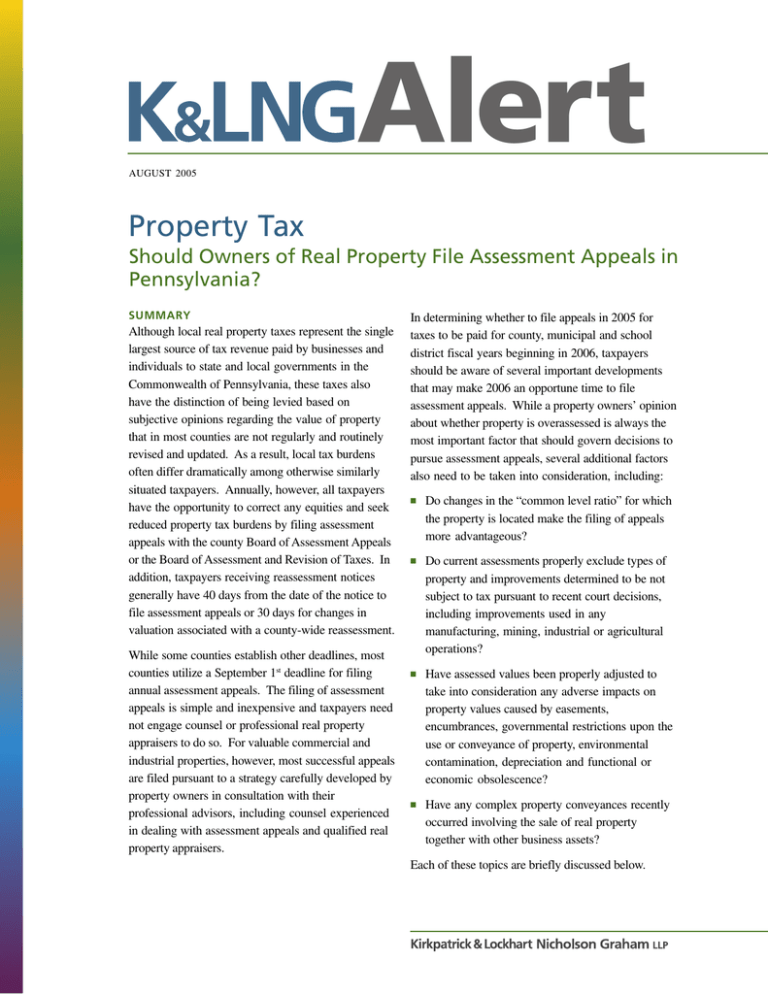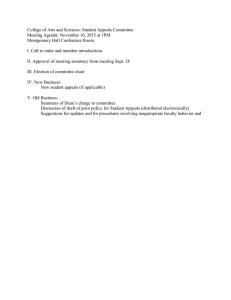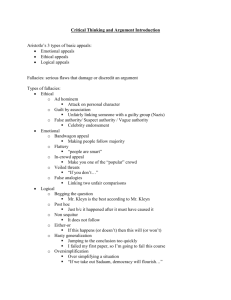
AUGUST 2005
Property Tax
Should Owners of Real Property File Assessment Appeals in
Pennsylvania?
SUMMARY
Although local real property taxes represent the single
largest source of tax revenue paid by businesses and
individuals to state and local governments in the
Commonwealth of Pennsylvania, these taxes also
have the distinction of being levied based on
subjective opinions regarding the value of property
that in most counties are not regularly and routinely
revised and updated. As a result, local tax burdens
often differ dramatically among otherwise similarly
situated taxpayers. Annually, however, all taxpayers
have the opportunity to correct any equities and seek
reduced property tax burdens by filing assessment
appeals with the county Board of Assessment Appeals
or the Board of Assessment and Revision of Taxes. In
addition, taxpayers receiving reassessment notices
generally have 40 days from the date of the notice to
file assessment appeals or 30 days for changes in
valuation associated with a county-wide reassessment.
While some counties establish other deadlines, most
counties utilize a September 1st deadline for filing
annual assessment appeals. The filing of assessment
appeals is simple and inexpensive and taxpayers need
not engage counsel or professional real property
appraisers to do so. For valuable commercial and
industrial properties, however, most successful appeals
are filed pursuant to a strategy carefully developed by
property owners in consultation with their
professional advisors, including counsel experienced
in dealing with assessment appeals and qualified real
property appraisers.
In determining whether to file appeals in 2005 for
taxes to be paid for county, municipal and school
district fiscal years beginning in 2006, taxpayers
should be aware of several important developments
that may make 2006 an opportune time to file
assessment appeals. While a property owners’ opinion
about whether property is overassessed is always the
most important factor that should govern decisions to
pursue assessment appeals, several additional factors
also need to be taken into consideration, including:
■
Do changes in the “common level ratio” for which
the property is located make the filing of appeals
more advantageous?
■
Do current assessments properly exclude types of
property and improvements determined to be not
subject to tax pursuant to recent court decisions,
including improvements used in any
manufacturing, mining, industrial or agricultural
operations?
■
Have assessed values been properly adjusted to
take into consideration any adverse impacts on
property values caused by easements,
encumbrances, governmental restrictions upon the
use or conveyance of property, environmental
contamination, depreciation and functional or
economic obsolescence?
■
Have any complex property conveyances recently
occurred involving the sale of real property
together with other business assets?
Each of these topics are briefly discussed below.
CHANGES IN COMMON LEVEL RATIOS
In several counties, substantial reductions in so-called
“common level ratios” published by a state agency
known as the State Tax Equalization Board have
generated significant opportunities for taxpayers to
reduce assessed values, even if assessments accurately
reflect the market value of property. These
opportunities arise in a number of counties, including
Berks, Bradford, Carbon, Centre, Chester,
Cumberland, Dauphin, Delaware, Fayette, Fulton,
Greene, Lancaster, Lehigh, Montgomery, Perry,
Schuylkill, Sullivan, Tioga and York Counties.
Each county in Pennsylvania is responsible for
annually determining the assessed value of property
within its boundaries. The assessed values determined
by the County Tax Assessment Office are then utilized
by the county, cities, boroughs, townships and school
districts to levy real property taxes. Tax rates are
stated in millage rates which are one-tenth of a percent
of assessed value. For example, a 27 mill tax is
equivalent to a tax of 2.7% of assessed value.
Assessments are based on a predetermined percentage
of market value of property. This percentage (which is
used to calculate assessed values based upon the
market value of property) is known as the
“predetermined ratio.” Where counties have recently
conducted county-wide reassessments, the amount of
tax levied upon a parcel of real property is generally
determined by multiplying the market value of
property by the predetermined ratio to calculate the
assessed value and by multiplying the assessed value
by the decimal equivalent of the millage rate. For
example, if a commercial or industrial property has a
market value of $2.5 million, in a county with a 25%
predetermined ratio, its assessed value should be
$625,000. A 27 mill property tax results in an annual
payment of $16,875, i.e., $625,000 x 0.027.
When assessments are not periodically adjusted or
rapid changes occur in the local real estate market, the
predetermined ratio may fail to accurately reflect the
actual difference between the market value of property
and tax assessments. The State Tax Equalization
Board is required by law annually to estimate the
actual ratio of market value to assessed value of
2 AUGUST 2005
property based upon property conveyances reported to
the County Recorder of Deeds. This amount is known
as the “common level ratio.” If a county utilized a
predetermined ratio of 25%, and the common level
ratio calculated by the State Tax Equalization Board
for the county was 6.6%, this means that, on average,
assessed values of property in the county reflect only
6.6% of market value rather than the standard 25%
predetermined ratio used by the county. Where the
common level ratio differs significantly (i.e., by more
than 15%) from the predetermined ratio, counties are
required by law to use the common level ratio rather
than the predetermined ratio in resolving any tax
assessment appeals.
“While some counties establish other deadlines, most counties
utilize a September 1st deadline for filing annual assessment
appeals.”
The most recent common level ratios published by the
State Tax Equalization Board saw seven counties fall
below the 15% threshold that allows the use of the
common level ratio in assessment appeals, i.e., Berks,
Bradford, Carbon, Dauphin, Greene, Schuylkill and
Tioga Counties. As a result, even if the market value
of an individual property did not change from 2004 to
2005 and the assessed value in 2004 accurately
reflected its market value, substantial opportunities for
reductions in assessed value may arise. For example,
Schuylkill County has a 50% predetermined ratio, but
saw its common level ratio fall from 43.2% to 41.4%
of market value between 2004 and 2005. Because a
41.5% common level reflects more than a 15%
difference from Schuylkill County’s predetermined
ratio (i.e., a ratio less than 42.5%), for appeals filed
during 2005 taxpayers may utilize the common level
ratio rather than the predetermined ratio. As a result,
tax reductions of 17.2% are possible if property values
have not increased and higher savings can be
achieved if properties are overvalued.
KIRKPATRICK & LOCKHART NICHOLSON GRAHAM LLP
In several other counties that previously fell below the
15% threshold allowing use of the common level ratio
in assessment appeals, significant reductions in
common level ratios also generated opportunities for
added tax savings. For example, common level ratios
dropped 4.4% in Centre County, 4.26% in Chester
County, 5% in Cumberland County, 7% in Delaware
County, 6.5% in Fayette County, 5% in Fulton
County, 5.8% in Lancaster County, 4.2% in Lehigh
County, 4.8% in Perry County and 5.9% in York
County. These drops in commonly level ratios
particularly make it more attractive to challenge tax
assessments to the extent that properties in these
counties are otherwise overassessed.
EXCLUSION OF PROPERTY NOT SUBJECT TO
LOCAL TAXATION
In an important 2002 decision, the implications of
which are only being recently understood, the
Pennsylvania Supreme Court in Independent Oil &
Gas Assn. v. Fayette County ruled that the only types
of real property and improvements subject to tax
assessment are the types of property and
improvements specifically listed in county assessment
laws. These properties are limited to land, buildings,
trailers or mobile homes, parking lots, industrial
facilities, offices and coal reserves. While the
Commonwealth Court has recently ruled that the term
“land” includes other types of hard mineral reserves
and attributes common ascribed to land itself,
numerous opportunities exist to challenge the
inclusion in assessed values of various types of
improvements and other property not expressly
subject to tax assessments.
A series of important decisions by the Commonwealth
Court between 2001 and 2005 in the matter of
Allegheny Energy Supply v. Greene County have also
broadly construed the extent to which machinery,
equipment and other improvements used in
manufacturing, mining, agricultural operations and
other industrial activities are excluded from real
property taxation. The Court found that the
machinery and equipment exclusion applies to all
improvements to real estate, whether attached to the
land or otherwise, which (1) are used directly in
3 AUGUST 2005
manufacturing, mining, agriculture or other industrial
activities; (2) are necessary and integral parts of such
activities; and (3) are used solely for effectuating such
purposes.
SPECIAL FACTORS AFFECTING PROPERTY
VALUES
Special characteristics of a property, limitations on the
use of the property or limits upon the financing or
rental income of the property may impact upon the
value of the property. For example, where a property
is subject to significant environmental contamination
and the property owner is willing to put that fact into
evidence, the property could be deemed unmarketable
and only a nominal market value assigned to the
property.
“In several counties, substantial reductions in... ‘common level
ratios’... have generated significant opportunities for taxpayers
to reduce assessed values... including Berks, Bradford, Carbon,
Centre, Chester, Cumberland, Dauphin, Delaware, Fayette,
Fulton, Greene, Lancaster, Lehigh, Montgomery, Perry,
Schuylkill, Sullivan, Tioga and York Counties.”
With respect to rental property, where there are income
restrictions as a result of federal or state regulations,
such as with subsidized housing, and an owner is
prevented from increasing the income earned on the
property, the Pennsylvania Supreme Court in In re
Johnstown Associates mandated that a court must take
into consideration that encumbrance. In 2003, the
General Assembly adopted legislation that codified
the holding of In re Johnstown Associates and
requires that “In arriving at the actual value of real
property, the impact of applicable rent restrictions,
affordability requirements or any other related
restrictions prescribed by any Federal or State
programs shall be considered.” In addition, the
legislation prohibits the consideration as income any
Federal or state income tax credits with respect to the
property.
The ruling of In re Johnstown Associates has been
extended to other property where the use of that
KIRKPATRICK & LOCKHART NICHOLSON GRAHAM LLP
property is encumbered by an unwaivable, certain
obligation. In those circumstances, it is the value of
the property in its encumbered form that controls.
Such encumbrances may include easements or rights
of way that detract from the marketability of the
property. Such encumbrances may also arise as a
result of a contractual limit on the amount of income
that may be generated by the property. For example, a
property owner enters into a long-term lease of the
property. Typically the property would be valued
pursuant to the cost approach using a reproduction or
replacement value. However, as a result of the
encumbrances, the income generated by that lease is
significantly lower than value of the property using
the cost approach. In that instance, the value of the
property must be considered in light of the
encumbrance, which not only will lower the value of
the property, but will require the use of a different
valuation methodology that will permit the
appropriate consideration of the encumbrance.
OPPORTUNITIES AND PROBLEMS POSED BY
BUSINESS ASSET SALES INCLUDING REAL
PROPERTY
Even in the absence of other problems affecting the
valuation of property, in order to reduce transfer taxes,
taxpayers may wish to consider pursuing assessment
appeals if they have recently completed or are
contemplating sales of business assets that include
real property. In such transactions, it is often difficult
to ascribe the amount of consideration paid for the
conveyance of real estate, and the Department of
Revenue has recently begun challenging conveyances
in which consideration used to calculate transfer taxes
is less than the assessed value of property divided
times the common level ratio for the year of the
transaction (an amount referred to as the “computed
value”). The Department has also in such transactions
often refused to consider appraisal reports as evidence
of the actual value of property.
To the extent a reasonable and up-to-date value is
determined pursuant to an assessment appeal, the risk
that computed values substantially varying from
market value will be used for real estate transfer tax
purposes is eliminated. In addition, to the extent taxes
were paid using inflated computed values, by filing
4 AUGUST 2005
and successfully prosecuting assessment appeals,
taxpayers may not only enjoy reductions in real
property tax burdens but generally are also able to
receive refunds for transfer taxes paid on computed
values in excess of actual values determined upon the
completion of assessment appeals.
THE ROLE OF LEGAL COUNSEL IN
ASSESSMENT APPEALS
The assistance of counsel may be critical in the
effective pursuit of tax assessment appeals. There are
a number of unique aspects of Pennsylvania law that
can affect property valuation for tax purposes,
including application of the machinery and
equipment exclusion, the effect of property
contamination (such as environmental contamination,
asbestos, etc.), zoning restrictions, the effect of
easements, property leased at above or below market
rates, and application and weighting of the various
accepted appraisal approaches. Knowledgeable legal
counsel can assist owners to develop a persuasive
presentation, identify helpful and unhelpful evidence,
prepare summary exhibits, enlist and work with
outside appraisers where appropriate, and otherwise
help property owners obtain optimal results. Thus, a
small investment in legal counsel may lead to a large
payoff in tax savings for many years to come.
“...In order to reduce transfer taxes, taxpayers may wish to
consider filing assessment appeals if they have recently
completed or are contemplating sales of business assets that
include real property.”
The law firm of Kirkpatrick & Lockhart Nicholson
Graham LLP (K&LNG) has represented property
owners in numerous counties across Pennsylvania,
and at every level of the assessment and exemption
appeals practice, from informal reviews and
corrections, to Board level appeals, Courts of
Common Pleas, Commonwealth Court of
Pennsylvania and the Supreme Court of Pennsylvania.
The firm has handled appeals involving office
buildings, department stores, shopping centers,
KIRKPATRICK & LOCKHART NICHOLSON GRAHAM LLP
manufacturing facilities (e.g., primary and specialty
metals, pharmaceuticals and electronics),
entertainment facilities, a railroad, a brewery, group
homes for mentally ill and retarded adults and
children, electric power plants, gas distribution
facilities and landfills.
Lawyers at K&LNG have also handled numerous
appeals for hospitals, nursing homes, cemeteries,
cultural facilities and extended care communities
regarding denials of real estate tax exemptions,
including the landmark matter of St. Margaret’s
Seneca Place before the Pennsylvania Supreme Court.
K&LNG is a national law firm with Pennsylvania
offices located in Harrisburg and Pittsburgh. Lawyers
in both the Harrisburg and Pittsburgh offices are
currently handling assessment appeals in many
counties throughout the Commonwealth.
Raymond P. Pepe
rpepe@klng.com
717.231.5988
Carleton O. Strouss
cstrouss@klng.com
717.231.4503
Jacqueline Jackson-DeGarcia
jjacksondegarcia@klng.com
717.231.5877
Christopher R. Nestor
cnestor@klng.com
717.231.4812
If you have questions or would like more information about K&LNG’s Property Tax Practice, please contact
one of our lawyers listed below:
Harrisburg
Raymond P. Pepe
Carleton O. Strouss
717.231.5988
717.231.4503
rpepe@klng.com
cstrouss@klng.com
412.355.6234
412.355.8682
ebloch@klng.com
dcohen@klng.com
Pittsburgh
Evan A. Bloch
David R. Cohen
www
w.. k l n g . c o m
BOSTON DALLAS HARRISBURG LONDON LOS ANGELES MIAMI NEWARK NEW YORK PALO ALTO PITTSBURGH SAN FRANCISCO WASHINGTON
■
■
■
■
■
■
■
■
■
■
■
Kirkpatrick & Lockhart Nicholson Graham LLP (K&LNG) has approximately 1,000 lawyers and represents entrepreneurs, growth and middle market
companies, capital markets participants, and leading FORTUNE 100 and FTSE 100 global corporations nationally and internationally.
K&LNG is a combination of two limited liability partnerships, each named Kirkpatrick & Lockhart Nicholson Graham LLP, one qualified in Delaware, U.S.A.
and practicing from offices in Boston, Dallas, Harrisburg, Los Angeles, Miami, Newark, New York, Palo Alto, Pittsburgh, San Francisco and Washington and
one incorporated in England practicing from the London office.
This publication/newsletter is for informational purposes and does not contain or convey legal advice. The information herein should not be used or relied
upon in regard to any particular facts or circumstances without first consulting a lawyer.
Data Protection Act 1988 - We may contact you from time to time with information on Kirkpatrick & Lockhart Nicholson Graham LLP seminars and with our
regular newsletters, which may be of interest to you. We will not provide your details to any third parties. Please e-mail cgregory@klng.com if you would
prefer not to receive this information.
© 2005 KIRKPATRICK & LOCKHART NICHOLSON GRAHAM LLP. ALL RIGHTS RESERVED.




